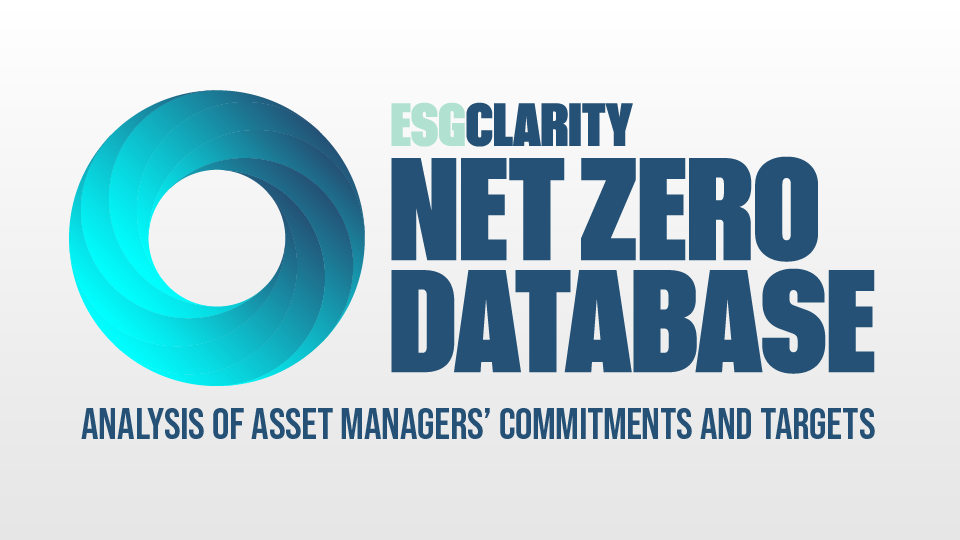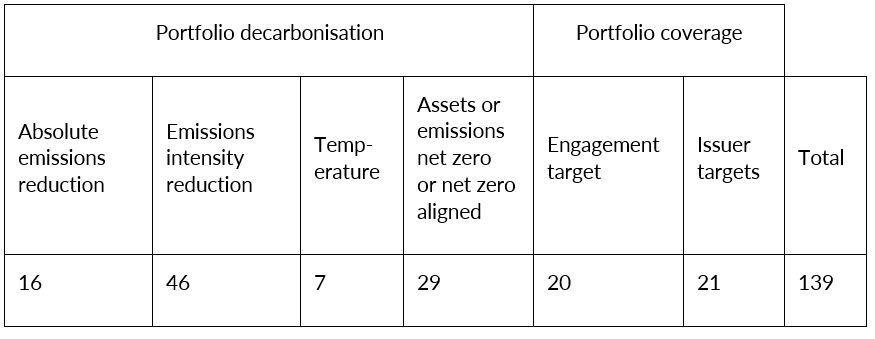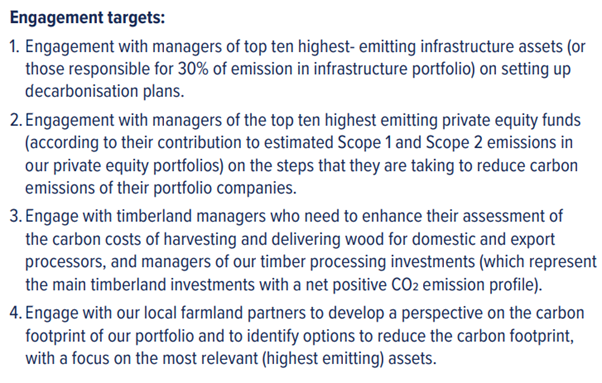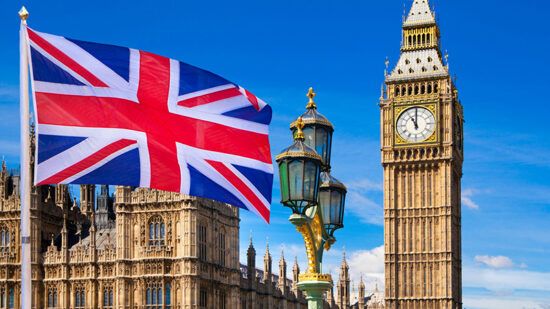Research carried out by ESG Clarity into investment groups’ net-zero commitments has found most asset managers setting targets are not in line with advice on achieving real-world impact.
ESG Clarity analysed data for 83 asset managers working towards net zero and also found smaller fund groups are, on average, committing a higher percentage of assets under management (AUM) to be net zero than larger groups.
The findings come as investor and civil society scrutiny on how assets are moving to net zero carbon emissions is increasing. For example, stricter criteria have been introduced by the UN-backed Race to Zero, the campaign behind the Net Zero Asset Managers Initiative (NZAM). Signatories now need to comply with stricter targets and reporting and must state how they will phase down and phase out unabated fossil fuels.
Background
NZAM was set up in 2020 for fund groups to commit to playing a part in meeting the Paris Agreement goal of keeping global temperature rise to within 1.5°C. However, ESG Clarity‘s research found the routes to this end goal are as varied as the number of NZAM signatories.
In summary, there are now 273 signatories, with 83 asset managers having published their net-zero targets so far. According to NZAM, the published initial targets represent 39% of the group’s assets and $16trn.
The initiative does not stipulate exactly how asset managers should set and reach their goals because it understands this would be unrealistic given the wide variety of business models and investment types behind the assets being committed to net zero.
However, the initiative has put some limitations on the target types and has encouraged signatories to include higher level portfolio emissions reduction targets as well as portfolio coverage targets – such as a percentage of issuers to have adopted science-based, net-zero targets.
NZAM highlighted looking only at portfolio-level emissions “can encourage investors to sell high carbon assets rather than engaging to drive real-world impact”, while using only the portfolio coverage approach “focuses on getting companies themselves onto a decarbonisation pathway, which achieves real-world reductions but can be more difficult to determine the portfolio emissions impact.”
ESG Clarity looked through all 83 asset managers’ targets to establish how the groups are setting their targets and if they stack up with what the initiative is advising.
Methodology
The signatories themselves are encouraged to use one or a combination of these methodologies for target-setting:
• Paris Aligned Investment Initiative’s Net Zero Investment Framework
• Science Based Targets initiative for Financial Institutions
• Net Zero Asset Owner Alliance Target Setting Protocol
ESG Clarity has looked beyond the methodologies chosen to the actual targets being set. To analyse data on those targets, they were grouped into six categories, four of which are generally used at the portfolio decarbonisation level: absolute emissions reduction, emissions intensity reduction, temperature target and net zero alignment for assets or emissions. Two are classed by NZAM as “portfolio coverage” targets and here include engagement targets and issuers themselves setting targets.
There are occasional exceptions to the former portfolio decarbonisation group; for example, WHEB stated one of its targets is to achieve carbon emission reductions from portfolio companies, whereas other groups tended to use carbon emission reduction targets for portfolios.
Further exceptions are where BMO is counted once as an asset manager among the 83 in this analysis, but has set separate targets for both BMO Global Asset Management (Canada) and BMO Global Asset Management (EMEA) – each committing a different level of AUM to be net zero. For this reason there are 84 groups counted in the analysis.
The database ESG Clarity has compiled on NZAM targets shows which of the targets each group is using.

Net-zero targets and impact
Number of target types groups are using:
| Number of target types: | How many groups using: | % of groups using: |
| 1 | 47 | 56 |
| 2 | 22 | 26 |
| 3 | 12 | 14 |
| 4 | 3 | 4 |
| 84 | 100 |
Despite the recommendation from the NZAM initiative to use a variety of target types and to use targets that show both real-world impact and portfolio decarbonisation, most groups, 56%, are only using one target type.
Of the 47 asset managers with only one target, 47% chose to use an emissions intensity reduction target, in effect, portfolio decarbonisation. The next most popular, at 23%, was a target that focuses on issuers themselves adopting targets. This is a type of portfolio coverage target considered a route to real-world impact. Within fund groups using two target types, only a quarter are portfolio coverage targets.
It is only when you analyse the groups using four types of targets, of which there are just three asset managers, that there is a better balance between the two main levels of targets being used, as the NZAM initiative recommends. The spread of target types for these three asset managers is 58% at the portfolio decarbonisation level and 42% at the portfolio coverage level.
All targets set by signatories

Taking all 139 targets set by signatories is another way to view the skew towards portfolio decarbonisation, which could, as NZAM stated, mean firms are divesting for a portfolio impact rather than a real-world impact. Only around 29% of targets were set at portfolio coverage level.
Stafford Capital is an example of a group with a portfolio coverage target on engagement, including engaging with managers of the top ten highest- emitting infrastructure assets on setting up decarbonisation plans.

While BlackRock is a group which has set a target for 75% of issuers to have science-based targets or equivalent.

Commenting on the findings, a spokesperson for the NZAM, said: “NZAM is clear on its requirement for investors to seek real economy emissions reductions.
“Targets and transition plans are therefore expected to be developed according to this goal and NZAM encourages investors to consider setting both emissions reduction and portfolio coverage targets.”
According to the spokesperson, a number of investors have said the emissions reduction approach allows them flexibility to manage portfolios in line with a science-based, greenhouse gas emissions reduction pathway through asset allocation, engagement and stewardship, or divestment.
“However, as the availability of company data and analysis increases, we anticipate seeing an increase in portfolio coverage targets in the future,” the spokesperson said.
The spokesperson described engagement as “an essential part” of efforts to decarbonise assets under management, regardless of how targets are set. Signatories are required to implement a stewardship and engagement strategy – with a clear escalation and voting policy – consistent with all AUM being net zero by 2050 or sooner.
The NZAM spokesperson said the initiative has a “fundamental focus” on driving change in the real economy – the initiative reviews signatories’ targets and transition plans to ensure they are fit to contribute to this goal.
Groups’ size and focus
An obvious difference that emerged between the smaller and larger NZAM asset managers was the percentage of AUM initially committed to net zero.
Out of the 84 groups, 26% committed 100% of their AUM to net zero. However, the rate of groups committing 100% is higher for the smallest 24 groups, which have $10bn AUM or less. Some 58% of this sample are committing 100% of AUM to be net zero.
At the other end of the spectrum there are the largest asset managers – the 23 groups with over $300bn AUM. Here, none committed 100% of AUM to being net zero.
It is also possible to look at how group size impacts the chance of an asset manager using the recommended combination of portfolio decarbonisation and portfolio coverage targets.
There was a similar chance for the largest and smallest investors, but for those with between $10bn and $100bn AUM, the chance of them using both main target types went from around a third to 14%.
It should be noted, a few – mainly smaller asset managers – used targets for the inclusion of climate solutions or exclusion of polluters. This type has not been included in the study due to practical limitations but would potentially show more groups using portfolio decarbonisation.
Further divergence
As part of NZAM signatories’ commitment, asset managers are also expected to consider “material Scope 3 emissions” – something that is a huge focus for the US regulator.
The data on Scope 3 carbon emission inclusion, however, shows it as another area of divergence across the groups.
In total, 46 firms, or 55%, said they do not include Scope 3 when setting and measuring against their net zero targets. Another 35% do use it but only partially and nine groups, 11%, said they use Scope 3 carbon emissions in setting and measuring targets.
Large deviations across NZAM signatories were to be expected considering the variety of businesses among them, but for those looking to understand and compare asset managers’ net-zero targets, the differences present a real challenge.
In particular, requiring fund groups to show, through their targets, how they are committing to real-world decarbonisation would improve usefulness for external stakeholders and could speed up the impact of the initiative as a whole.
Look out for more analysis stories based on the findings of our net-zero research and database.








